Beautiful historical monuments are considered as one of the tourist attractions of any city and region. The city of Tehran, with a history of being the capital for 200 years, has snatched the lead from other cities and has housed luxurious mansions. Tehran’s palaces and museums, which belong to recent centuries, receive millions of Iranian and foreign visitors every year. Golestan Palace in Tehran is one of the most beautiful buildings that was the site of the most important historical events in Iran during the Qajar period.
History of Golestan Palace – Tehran
According to historical documents as well as the travelogue of Pietro Della Valle, the history of Golestan Palace dates back to the time of Shah Abbas Safavid (r 1588-1629); However, the most important historical period of this palace is related to the Qajar era (1789-1925). After defeating Lotf Ali Khan Zand, Agha Mohamad Khan Qajar was crowned in 1789 and moved the capital from Shiraz to Tehran; an event that gave double importance to the royal citadel of Golestan.
The place that is known today as the Golestan Heritage Museum Palace was once the royal citadel of Shah Abbas Safavid (r. 1588 – 1629). At that time, Tehran was just a small village near the historic city of Rey . Tehran was first privileged by the Safavid kings due to its pleasant climate and proximity to Shemiranat and Lavasan, which were considered summer areas. In this way, a citadel was built in Tehran, which was surrounded by plane trees.
With the end of the Safavid and Afshari eras, during the Zand period, this complex was used occasionally by a king called Karim Khan, and a section that is known today as Khalvat-e Karim Khani meaning Karim Khani Nook was added to it. With the coming to power of Agha Mohammad Khan and the establishment of the Qajar dynasty, Tehran was chosen as the capital of Iran. At this time, the royal citadel became the main palace of the kings. This place witnessed the coronation and condolence ceremonies of each of the Qajar kings.
Agha Mohammad Khan Qajar
Agha Mohammad Khan Qajar (14 March 1742 – 17 June 1797), was the founder of the Qajar dynasty of Iran. Originally chieftain of the Qoyunlu branch of the Qajar tribe, Agha Mohammad Khan was enthroned as the king of Iran in 1789, and ruled Iran until 1797. He deposed Lotf Ali Khan of the Zand dynasty in 1794.
Agha Mohammad Khan Qajar was famously the eunuch Monarch, being castrated as a young adult upon his capture by Adel Shah Afshar, and hence was childless. He was assassinated on 17 June 1797, and was succeeded by his nephew, Fath-Ali Shah Qajar.
Agha Mohammad Khan’s reign is noted for the return of a centralized and unified Iran and for relocating the capital to Tehran, where it still stands today. He is also noted for his cruel and rapacious behavior, particularly during the re-subjugation of Georgia. He sacked the capital Tbilisi, massacred many of its inhabitants, and moved some 15,000 Georgian captives back to mainland Iran.
Golestan palace site map
Golestan Palace World Heritage Site
On 11 October 2005, the Cultural Heritage Organization of Iran submitted the palace to the UNESCO for inclusion into the World Heritage List in 2007. On 23 June 2013, it was proclaimed as world heritage site during the UNESCO meeting in Phnom Penh. The Golestan Palace is currently operated by the Iranian Ministry of Tourism & Cultural Heritage.
Golestan Palace Sites & Sections
In its present state, Golestan Palace is the result of roughly 400 years of renovations. The complex consists of 17 structures, including palaces, museums, and halls most of which was built during the 131 years of rule of Qajar rule. These palaces were used for many occasions such as coronations, celebrations, rituals, and for living. The complex also consists of three main archives, including the photographic archive, the library of manuscripts, and the archive of documents. At present, the area of Golestan Palace reaches 4.5 hectares, which is one tenth of the original size.
1
Marble Throne Terrace
This spectacular terrace, known as the Marble Throne Terrace dates back to the time of Agha Mohammad Khan and his coronation took place in this building. It is even said that the life of some parts of this building is longer than the life of Golestan Palace. During the Qajar era, kings used to receive governors in this place and met ordinary people during the Nowruz celebration in Iran
Adorned by paintings, marble-carvings, tile-work, stucco, mirrors, enamel, woodcarvings, and lattice windows, the throne terrace embodies the finest of Iranian architecture. This building remained as the place of coronation and Nowruz greetings of Qajar kings. The last ceremony held in this place was the coronation of Reza Shah in December 1925 after the establishment of his new kingdom.
In Pahlavi period, Golestan complex was only used for some ceremonies and residential palaces were moved to Sa’ad Abad palace complex and Niavaran palace complex, both located in north Tehran.
2
Shams ol-Emareh
Golestan Palace complex is a great place to immerse yourself in Iranian architecture from the Zand period until today. In different periods, especially during the Qajar era, various buildings were added to this complex, which resulted in a unique Emperial palace that encourages us to visit it today. Among the various buildings in Golestan, one of them, known as Shams ol-Emareh mansion – meaning “The Edifice of the Sun” – is considered the most stunning structure of the Golestan Palace whose unique glory amazes everyone.
Before his visit to Europe, Naser al-Din Shah, the fourth king of Qajar Dynasty, was thinking of building a mansion in his capital to compete with Isfahan’s Ālī Qāpū. A tall building that he could stand on its roof to have panoramic views of entire capital city. By his order, Shams ol-Emareh building was started in 1865 and was finished in two years. The style of this building is a combination of traditional Iranian and Western architecture.
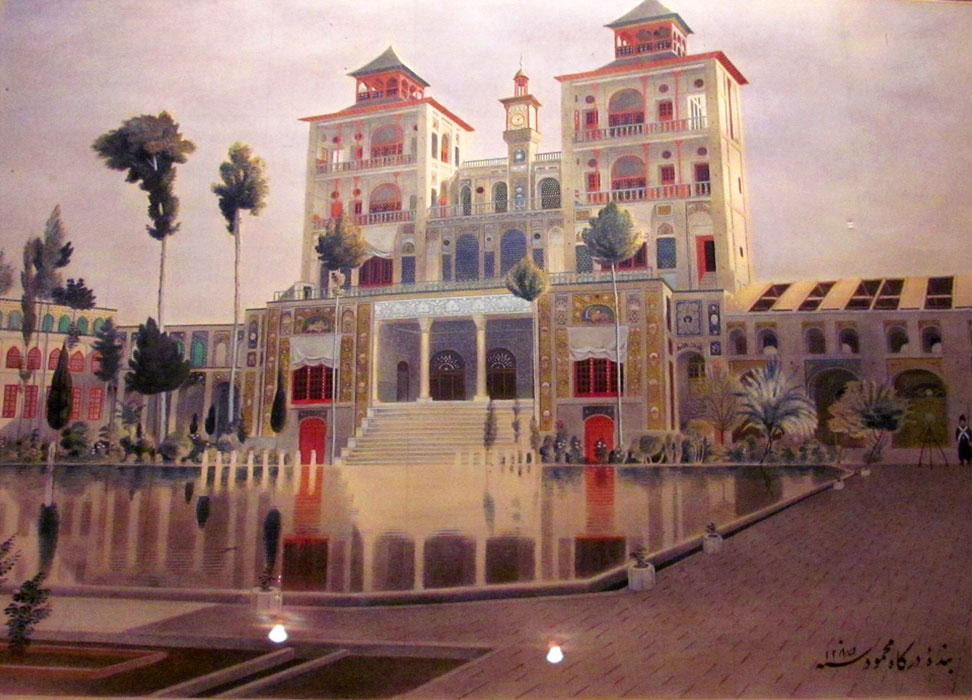 Shams ol-Emareh, painting by Mahmood Saba – 19th c
Shams ol-Emareh, painting by Mahmood Saba – 19th c
Shams ol-Emareh was the first Iranian building to be constructed of a metal structure, which has since become more common. As mentioned, this 5-storey palace was the tallest building in Tehran of 19th century, which is about 35 meters high.
There are different halls and rooms in this building with different functions. Their beauty and decorations will attract your attention as soon as you enter. These halls and rooms were used in various occasions, dinning halls, bed chambers, banquet halls, tea rooms, balconies and spaces for entertaining the king’s guests. But one of the most important parts of the mansion is the top floor, which is called the “Royal Seat”. This place was designed for Nasser al-Din Shah to sit and have an overview of the city of Tehran in front of his eyes and overlook the city from four sides.
Unfortunately, visitors can only visit the ground floor and not allowed to the upper floors of Shams ol-Emareh. The reason is to maintain the building and prevent some dangers.
Naser al-Din Shah (1831-1896)
Naser al-Din Shah (r. 1848-1896) has the longest reign among almost all Iranian kings throughout the history (ruled for 50 years). He was also the first king of Iran to write his memoirs, and he was also the first Iranian king to head a governing delegation to visit Western civilization and technology in modern Europe. The first king to bring modernity to Iran, the founder of most of the new institutions in the country, Naser was the first Iranian king to visit Europe. He loved travel, photography, poems, and art. During his reign, Nasser al-Din Shah did things that were done for the first time in Iran.
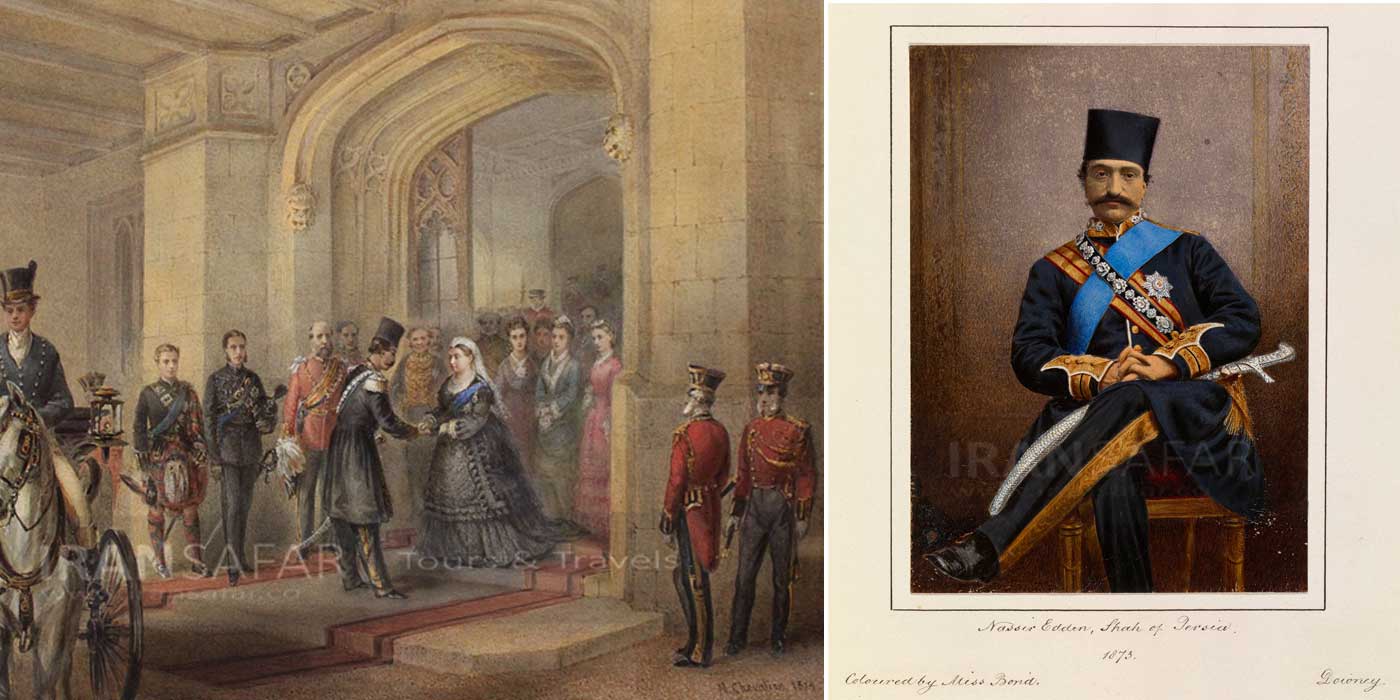 Naser al-din Shah’s state visit to the Great Britain, 1878
Naser al-din Shah’s state visit to the Great Britain, 1878
Many of these were important measures that had a positive effect on improving the quality of life or the progress of the country. We review the services that happened for the first time by him in Iran:
- Construction of the first school in Iran
- The first royal visits to Europe
- Establishment of a government council and six ministries
- Establishment of the Supreme Court of justice
- Establishment of the first bank in Iran
- Printing of the first banknote
- Printing the first stamp
- First telegram in Iran
- Establishment of the first national museum
- Establishment of the first zoo
- Establishment of the first railway
- Iran’s first industrial factory
- The first Iranian photography studio
- Irrigation projects through Persia
Naser al-Din was assassinated when he was visiting and praying in a holy Shrine on 1 May 1896.
3
Karim Khani Nook
Originally, this terrace was a part of the interior residence of Karim Khan, the founder of Zand dynasty. Dating back to 1759, The basic structure of the Karim Khani Nook is similar to the Marble Throne terrace. There is also a small marble throne inside this porch with less ornamentation compared to the other one. There was once a small pond with a fountain in the middle of this terrace. Water from a subterranean stream (the king’s qanat) flowed from the fountain into the pond and was later used to irrigate the palace grounds.
One of the valuable works of art located in this part of Golestan Palace is the tombstone of Naser al- Din Shah. This stone is made of solid marble and was made after the assassination of the king in 1896. This tombstone was originally placed on the grave of Naser al-Din Shah in the city of Rey and was transferred to Golestan Palace after the Islamic Revolution.
4
Salam Hall
Salam Hall or Museum Hall or Coronation Hall is located on the main central section of Golestan Palace, which was built from the beginning with the aim of creating a museum. Nasser al-Din Shah, seeing the museums of Western countries, decided to build a similar museum in this royal palace. In this regard, the old buildings of this part of the garden were destroyed and the Salam Hall was built. Thus, the first museum of Iran was formed in this hall which was used to exhibit Iranian and European paintings alongside gifts presented to the Iranian court. Some royal jewels were also exhibited inside glass cases.
Since the Salam ceremony was also held in this place, it was known as the Salam Hall and later it was known as the Coronation Hall because of the coronation of the Pahlavi kings that took place there.
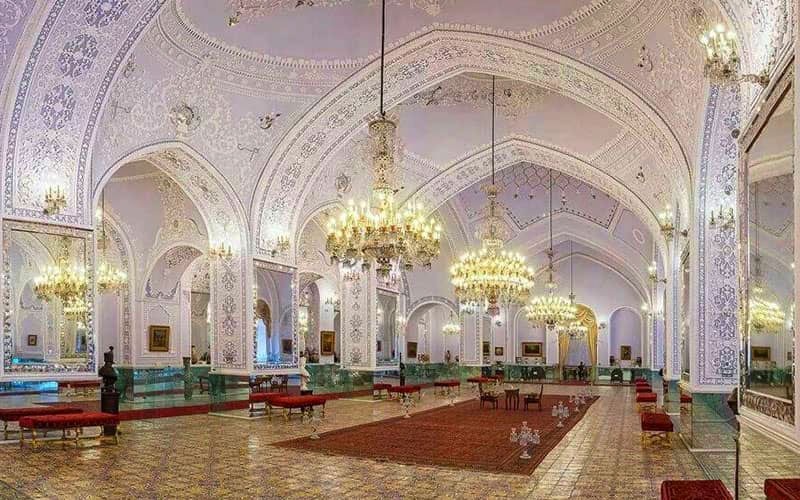 Salam Hall, Golestan Palace, Tehran, Iran
Salam Hall, Golestan Palace, Tehran, Iran
5
Golestan Palace Mirror Hall (Talar-e Ayneh)
The Mirror Hall is the most famous of the halls of the Golestan Palace. The construction of this hall was started in 1874 and took three years. But its decoration and mirror work took nearly more 4 years, and finally in 1881 the construction process was completed. In this hall, a very beautiful mirror work has been used, which has doubled its beauty. The interior of the hall is inspired by original Iranian architecture and art. All the walls of this hall are decorated with colored and handmade mirrors. All the colored mirrors used in the hall have been designed and made by Iranian artists.
Mirror Hall Painting
Ten years after the construction of the Mirror Hall (1882) a famous Iranian realist painter Kamal-ol-Molk, depicted a painting of the Mirror Hall with oil on canvas; his first work since receiving the title Kamal-ol-Molk (“Perfection of the Realm”). This painting is considered one of Kamal-ol-Molk’s masterpieces, and marks a starting point in Iran’s modern art.
He took five years to create this masterpiece to show the real reflections of mirrors, the reflection of lights on carpets, curtains and chandeliers as beautifully as possible. This painting was painted in a way that the hall looks wider and more glorious than reality. In “Mirror Hall” painting, Naser al-Din Shah can be seen seated on a chair in the center and watches the Golestan garden outside the window.
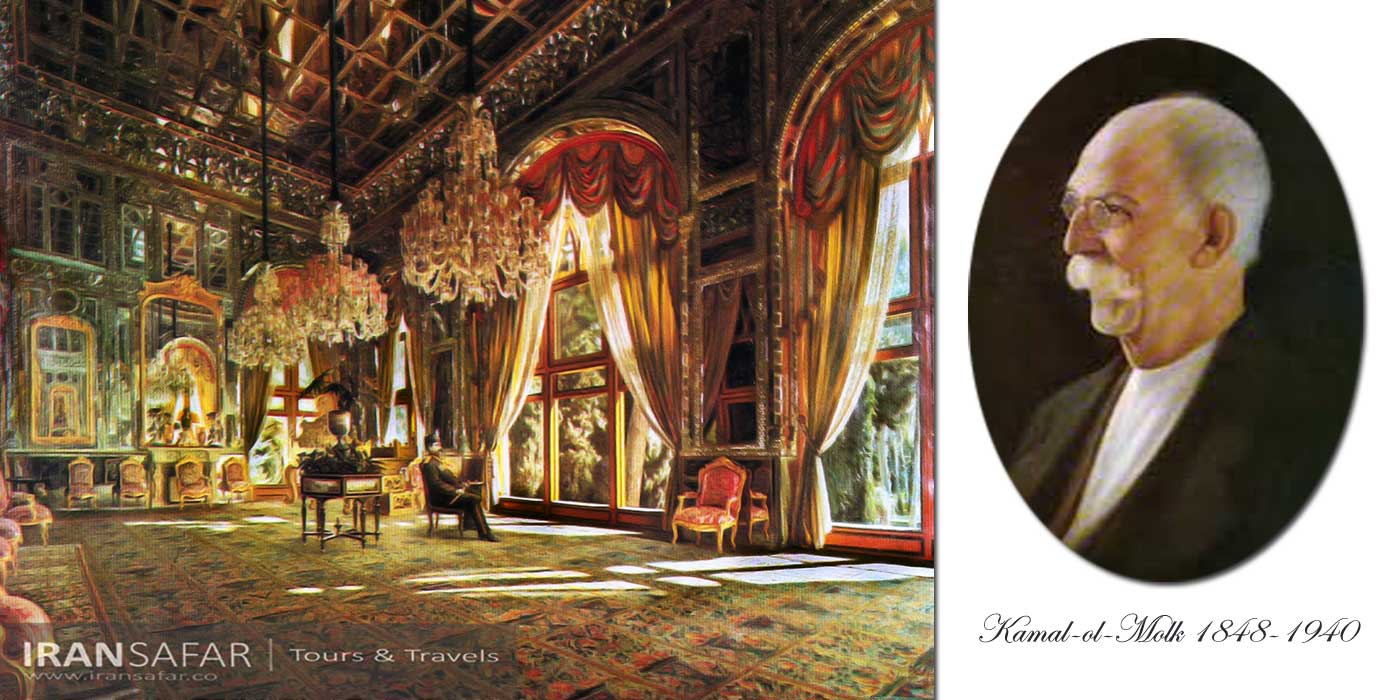 Mirror Hall painting by Kamal al-Molk, Golestan Palace, Tehran, Iran
Mirror Hall painting by Kamal al-Molk, Golestan Palace, Tehran, Iran
6
Ivory Hall (Talar-e Adj)
Ivory Hall is a large chamber used as for dining. Certainly, this one was built before Salam Hall and Mirror Hall and is one of the buildings of Nasser al-Din Shah period, but later in his time, its facade was changed to be in harmony with the other two halls. It was decorated with some gifts presented to Nasser ed Din Shah by European monarchs.
During Pahlavi period, Ivory hall was the place of reception and official parties of the court; Hence, major changes have been made in its internal arrangement
7
Dimond Hall (Talar-e Almas)
The Almas Hall is located in the southern side of the Golestan Palace, next to the wind tower building. It is called Talar e Almas (“the Diamond Hall”) because of the exceptional mirror work inside the building resembling diamond. Today, the Diamond Hall has been converted into a museum. The construction of this hall dates back to the time of Fath Ali Shah (r. 1797 -1834) and it is now hosting an exhibition of statues and paintings from the same period.
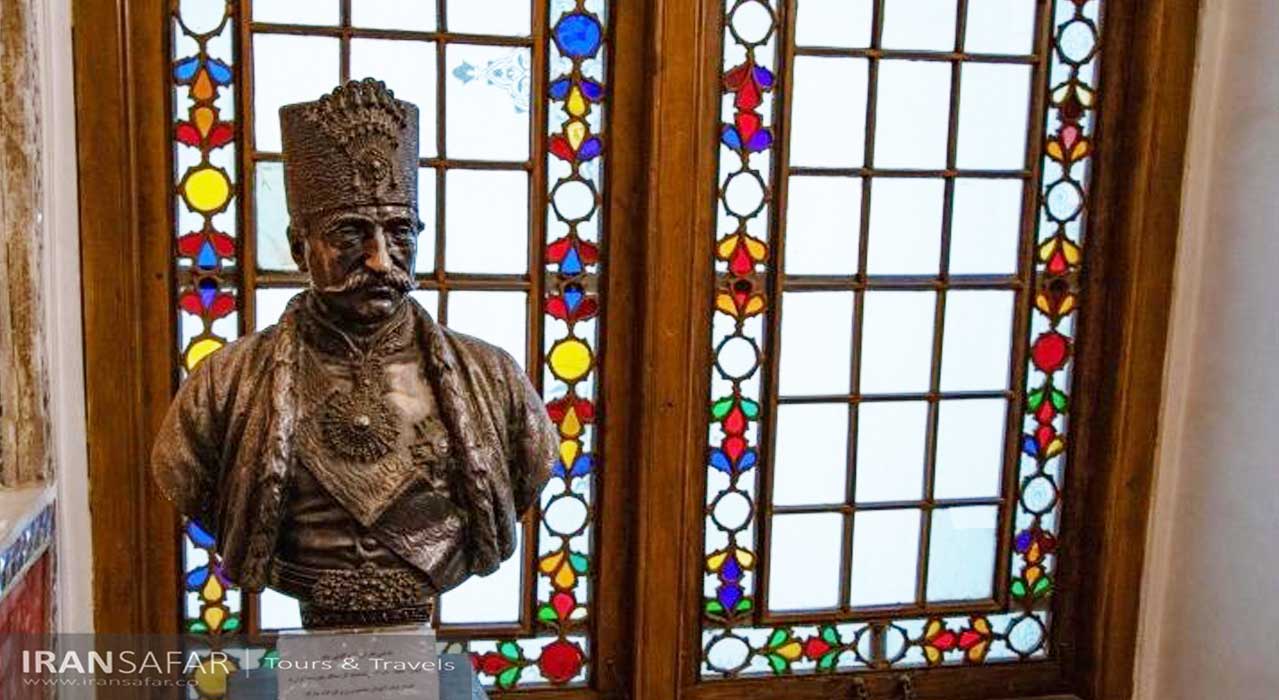 Bronze Statue of Naser Al-Din Shah
Bronze Statue of Naser Al-Din Shah
8
The Edifice of Wind Tower (Emarat-e Badgir)
Emarat-e Badgir meaning the Edifice of Wind Tower was constructed during the reign of Fath Ali Shah and is the third oldest building in Golestan Palace. This edifice underwent major renovations, including structural changes, during the reign of Nasser-al Din Shah.The name of this building is derived from the tall wind towers of this building that allow the cooling wind move through the structure.
9
Abyaz Palace – The Museum of Anthropology
At the end of the reign of Nasser al-Din Shah, the Ottoman king Sultan Abdul Hamid gifted some excellent and precious furniture, including a few pieces of Louis XVI living room sets, velvet curtains, gold and bronze sculptures, and a few pieces of Turkish carpet.
Because at that time almost all the royal palaces and halls were filled with numerous objects such as paintings and furniture and there was no place to present and install the gifts of the Ottoman Sultan, so Nasser al-Din Shah decided to construct a new building at the southwest corner of Golestan area, to house the gifts of the sultan.
It is said that Nasser al-Din Shah himself designed the new palace and calculated the dimensions of the great hall according to the width and length of the Sultan’s largest carpet.
However, when the building was completed, it was called the “Abyaz Palace” – meaning white palace -because of the whiteness of the façade, which was plastered and decorated in the style of 18th-century European buildings, and the steps and steps of the palace hall were made of white and streaked marble.
After the completion of the building, Nasser al-Din Shah ordered the large carpet of the Ottoman Sultan to be installed in this hall, and also some large portraits of the European kings and queens which were given as memorials to Iran during their travels in Persia.
The prime ministers of the later governments also established their own government headquarters in the same palace, and the meetings of the cabinet were held in the Abyaz hall.
As an Anthropology Museum
The establishment of the Anthropological Museum dates back to the early years of the Pahlavi era. The order to establish this museum was issued by Reza Shah Pahlavi in 1935. After the issuance of this decree, experts were sent to all parts of the country to collect the objects and necessities of life of the people of different cities, villages and ethnic groups. In September 1337, after a lot of effort, this museum was opened in a building located on Bouali Street, which is now the location of the Association of National Works and Honors of Iran.
The Anthropology Museum is one of the oldest and richest anthropological museums in the country.
Golestan Palace Entrance Fee
The entrance fee for Golestan Palace is set at 6,500,000 Rials for the whole complex (Update – July 2023)
You can buy one single ticket for multiple palaces, halls and museums. Online ticket service is not available.
Phone: (+98) 21- 33956662
Website: golestanpalace.ir
Attention: The upper floors of Shams ol-Emareh edifice are not open to visitors.
How to Reach Golestan Palace
Golestan Palace is located on Panzdah-e Khordad Street and Arg Square in Tehran. To go to Golestan Palace, we suggest you to take a taxi or to use subway to Panzdah-e Khordad metro station . Golestan Palace does not have a parking lot, and the alleys and its surrounding streets are very crowded. Note that Golestan Palace has two entrances, one is from Arg Square and the other is from Naser Khosrow Street.

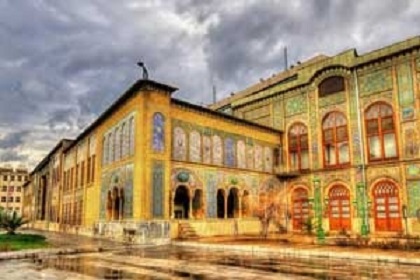

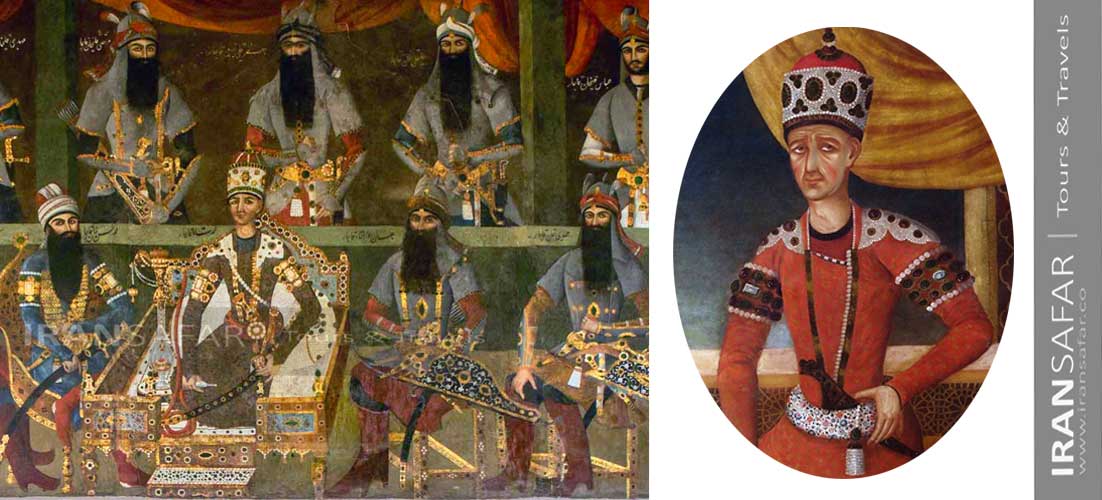
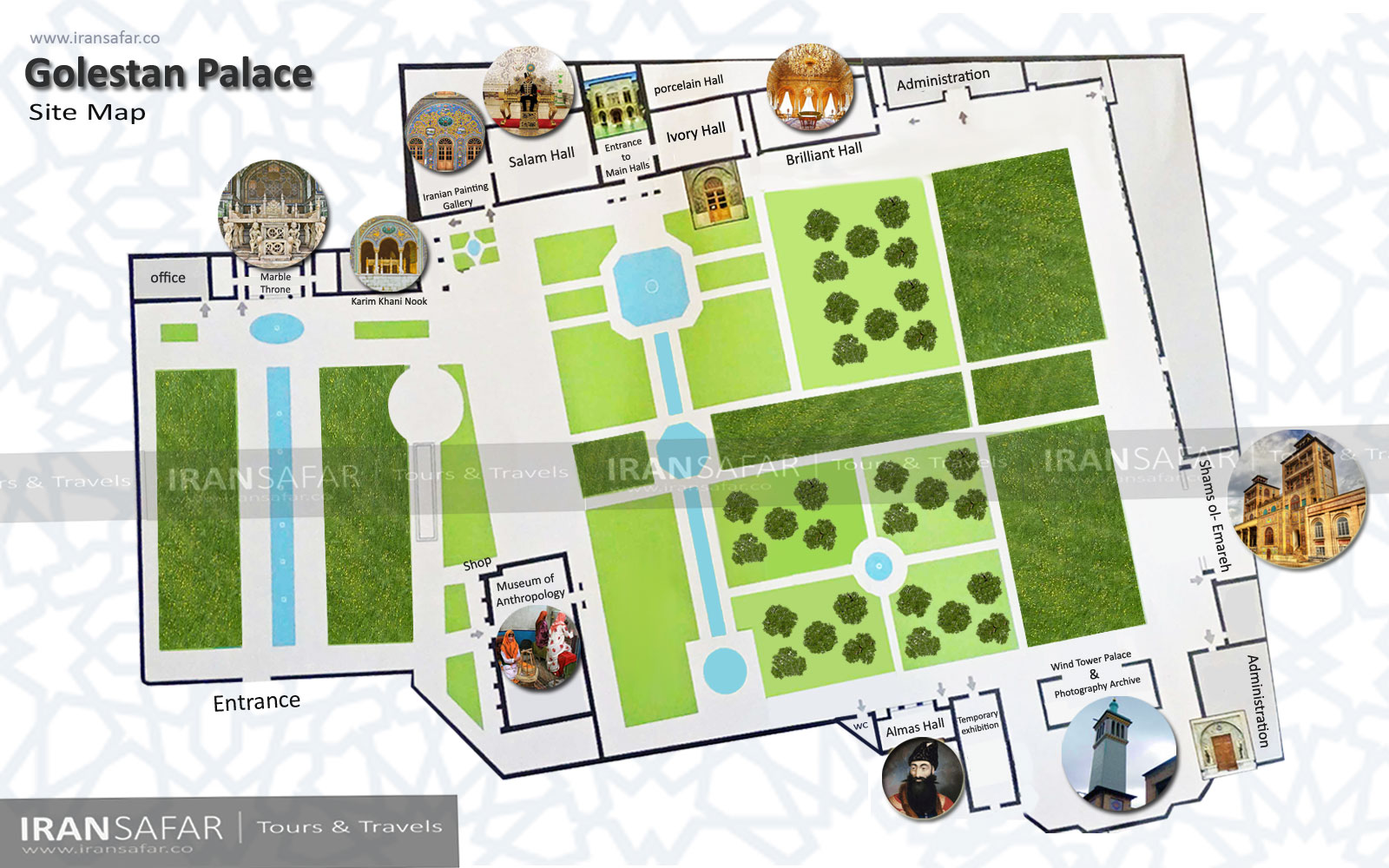
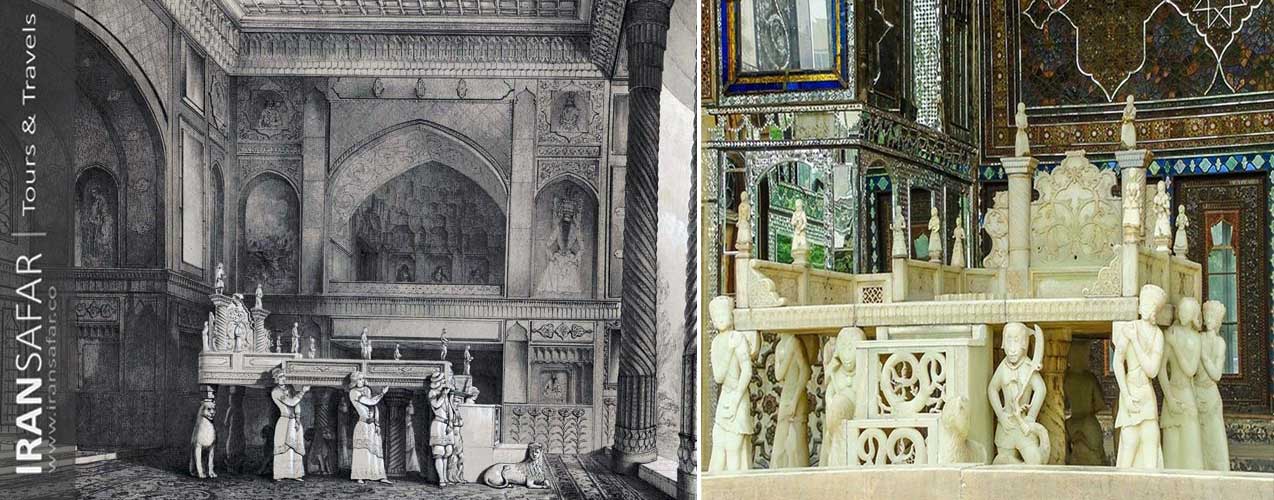

Golestan Palace is the oldest government building in Tehran registered as a UNESCO world heritage site. I was really amazed by the mirror works in interior part of the “Brilliant Hall” and the colorful tile works in the courtyard.